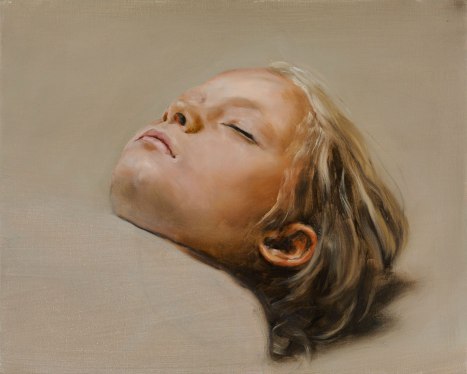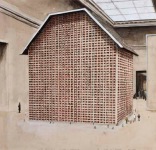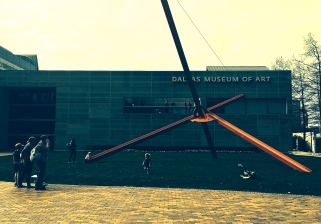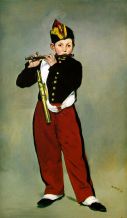The Artist Conversation (please see Part 1 for insights on the Borremans exhibit)
After savoring the exhibit, “As Sweet as It Gets” by Michaël Borremans at the Dallas Museum of Art, I walked, passing a lively concert in the dining area of the museum, to an auditorium for the Artist Conversation. After introductions were made, Borremans and curator, Dr. Jeffrey Grove, launched into several interesting topics. First, the artist  mentioned how important titles are to his work. Usually I think of titling the work upon completion, but the language describing an idea is something Borremans thinks about earlier in the process. Sometimes, he explained, he titles the work before producing the piece (which may be more like titling an idea), sometimes during, and sometimes after. Choosing language to attach to a visual image is an important part of Borremans’ process and contributes to his perspective on his job as an artist, “Making art is a form of communication. It is a dialogue.” While his work tends to lack complete answers, the text he uses in titles offers hints of insight, nudging us along as we try to understand.
mentioned how important titles are to his work. Usually I think of titling the work upon completion, but the language describing an idea is something Borremans thinks about earlier in the process. Sometimes, he explained, he titles the work before producing the piece (which may be more like titling an idea), sometimes during, and sometimes after. Choosing language to attach to a visual image is an important part of Borremans’ process and contributes to his perspective on his job as an artist, “Making art is a form of communication. It is a dialogue.” While his work tends to lack complete answers, the text he uses in titles offers hints of insight, nudging us along as we try to understand.
Throughout the conversation, he expressed an awareness of the impact his art has on audiences, how his work is perceived, and what ideas are communicated. “As an artist,” he stated, “I should always be critical of what I am doing.” Furthermore, and in a departure from many contemporary artists, Borremans stated that an artist must be careful about the art he puts in public places; he does not want his work to disturb people. I found this remark to be especially insightful a few minutes later as he discussed how he hopes people will perceive his work – he strives for a balance between beautiful and dark and wants people to see both, not just one or the other. “I want to make a painting that is just as beautiful as it is violent…I want that contradiction.” Sometimes the work is more beautiful than violent…  And sometimes it is more violent than beautiful…
And sometimes it is more violent than beautiful…
 But usually, he strikes a perfect balance…
But usually, he strikes a perfect balance…
 As I often feel overwhelmed with pervasive media sources in modern life, I was especially grateful to hear the artist express frustration with the abundance of imagery that assaults our eyes, ears and minds. He explicitly recommended we take responsibility for what we let in and be critical of what we allow in our minds. This is a point people either wholeheartedly understand or flat out don’t. I don’t read gossip magazines or give them to my children…there are too many incredible things to fill our minds – a movie star’s failed tummy tuck simply does not have a place on my radar. “Pick and choose purposefully, and simplify,” Borremans advised.
As I often feel overwhelmed with pervasive media sources in modern life, I was especially grateful to hear the artist express frustration with the abundance of imagery that assaults our eyes, ears and minds. He explicitly recommended we take responsibility for what we let in and be critical of what we allow in our minds. This is a point people either wholeheartedly understand or flat out don’t. I don’t read gossip magazines or give them to my children…there are too many incredible things to fill our minds – a movie star’s failed tummy tuck simply does not have a place on my radar. “Pick and choose purposefully, and simplify,” Borremans advised.
When discussing the use of technology compared to traditional methods in art making, he stated, “Painting is very basic. It is a tool, like a hammer. We will always use it.” When  considering other mediums that interest him, he continues to gravitate toward painting. “You can create a win
considering other mediums that interest him, he continues to gravitate toward painting. “You can create a win dow on another world, a world you cannot enter. You can’t do this with sculpture. Sculpture is in our space, our world.” Though Borremans does work with sculpture, it is not something he feels ready to show. It is as if sculpture is a studio tool he uses to dig deeper into his painting and drawing ideas. For example, he explained the painting, Four Fairies, 2003, was initially created to become a sculpture. Additionally, as mentioned in the previous blog entry, the artist investigates ideas using a cross medium technique ov
dow on another world, a world you cannot enter. You can’t do this with sculpture. Sculpture is in our space, our world.” Though Borremans does work with sculpture, it is not something he feels ready to show. It is as if sculpture is a studio tool he uses to dig deeper into his painting and drawing ideas. For example, he explained the painting, Four Fairies, 2003, was initially created to become a sculpture. Additionally, as mentioned in the previous blog entry, the artist investigates ideas using a cross medium technique ov er many years. “I have a very long dialogue with my drawings. I pull them out of the drawer and go back and work on them for many months, or years.” He will draw something, make a model of it, redraw it based on the new model, make a video with the model, and create a series of paintings based in the video (see the House of Opportunity series with various pieces produced from 2002 – 2013) .
er many years. “I have a very long dialogue with my drawings. I pull them out of the drawer and go back and work on them for many months, or years.” He will draw something, make a model of it, redraw it based on the new model, make a video with the model, and create a series of paintings based in the video (see the House of Opportunity series with various pieces produced from 2002 – 2013) .
Borremans made an intriguing statement about painting from nature when Dr. Grove asked about the recent appearance of animal subjects in the work. He stated once something is dead, it loses its previous meaning, identity. By not living, it becomes a different thing, an object instead of an animal. I am curious about his frequent use of dead animals and animal models (the models are in the form of figurines with a glaze sheen emphasizing their falseness). The various animals in his work cause a confusing thought process about what is real and wha t is fake, what is inanimate, and what is animate, and how the definitions o
t is fake, what is inanimate, and what is animate, and how the definitions o f these terms becomes blurry.
f these terms becomes blurry.
Borremans became especially animated when he talked of a turning point that was the consequence of getting stuck in 2012. He had many ideas but could not focus or turn the ideas into work. The solution came in the form of a new workspace when a friend offered to let Borremans move his studio into a chapel. The change of space, and working alone with only a Virgin Mary figure to keep him company, provided intense focus and infused his thoughts with memories of a Catholic upbringing. He stated that in the new workspace “the holy spirit came to me.” He seemed to say this in both jest and seriousness, explaining that one never completely shakes off early and strong religious influences provided by devout Catholic parents. “It sticks with you,” he stated, “It doesn’t mean I’m a practicing Catholic but it is part of me and part of our culture and I allow it.” 
I ALLOW IT. Mmm, this reminds me of his earlier comments about allowing only certain images to enter his environment and about consciously constructing the world we choose. My thoughts are tempted to dive off into a deep discussion (thought I’m not sure I’m entirely capable) on free will, hyperreality and commercialism of modern life…but I really want to stick with the exchange between Grove and Borremans.
Though he did not speak in depth about other artists, Borremans did refer to the artistic evolution of greats such as Goya, Velazquez and Rubens. “They never stopped learning, experimenting, and changing in order to continue to develop ways to communicate ideas.” The exhibit, “As Sweet as It Gets” showcases a thoughtful artist roughly midway through an evolving career and based on the evidence, I suspect it will get even sweeter. In discussing his prior career as an etching and drawing teacher and his decision to leave teaching, Borremans eloquently states, “You put everything at stake to become what you really are…I thought if I failed, at least I tried.” Thank goodness he tried.
PS Sincere thanks to Sid and Richard for your hospitality. And for anyone in the Dallas area, do yourself a  favor and stop by one of the two locations of The Gem!
favor and stop by one of the two locations of The Gem! 
Next post…shifting from an established artist to an emerging artist…video clips and comments about my current body of work, now showing at Boswell Mourot Fine Art through April 2nd. Thank you for reading!



















